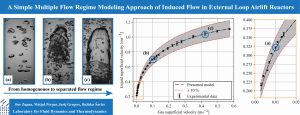Researchers from the Faculty of Mechanical Engineering at the University of Ljubljana have developed a new theoretical model that enables precise prediction of fluid movement in specialized industrial reactors known as airlift reactors. This opens the door to faster development of technological processes, reduced energy consumption, and increased efficiency in industry.
Airlift reactors are used in many industries – from chemical and biotechnological to energy – where circulating fluid is driven by injected gas. These reactors are popular due to their simple design and good performance, but designing them remains a challenge. The main difficulty lies in predicting fluid motion, which is hard to determine reliably due to complex dynamics.
Traditional methods for predicting flow in ALRs often rely on empirical equations, which do not always perform well across different reactor designs or operating conditions. The new model developed by researchers at the University of Ljubljana overcomes these limitations by consistently applying physical laws. It accounts for the balance of forces in the reactor and key factors such as gas flow rate, reactor geometry, and fluid properties.

The model was validated using existing experimental data from the literature as well as the researchers’ own measurements. It allows for accurate prediction of liquid recirculation velocity across various flow regimes – for example, from bubbly to slug flow. The researchers also introduced a new reactor constant in the model, which combines geometric and hydrodynamic characteristics of the system and enables easy calibration for different types of airlift reactors without the need for correction factors.
The results were published in the prestigious scientific journal Applied Thermal Engineering (Impact Factor 6.4), which covers topics in heat transfer, thermodynamics, and process engineering. The authors believe that their model represents an important addition to current knowledge, as it combines physical consistency with practical applicability.
“With the developed method, engineers can assess reactor performance early in the design phase without the need for lengthy experimental tests. This means faster process development, lower costs, and improved energy efficiency,” explains Bor Zupan.
The research also lays the groundwork for future upgrades to the model, which could include multiphase flows with more complex dynamics or the effects of chemical reactions—broadening its use across a wider range of industrial applications.
